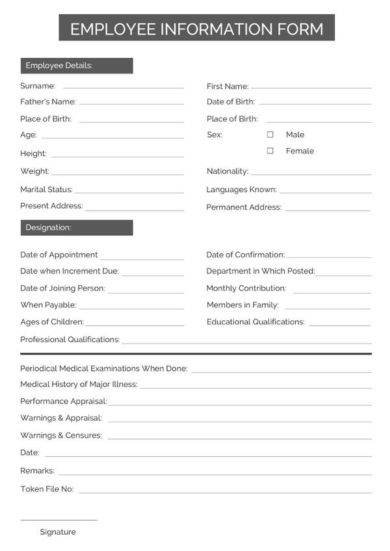17+ Employee Inion Form Examples to Download
Companies, no matter how large or small, hire employees. Without employees, companies or businesses would cease to exist. Detailed employee records are a requirement for companies these days, and gone are the days where companies would just list down the names of their employees and that would serve as the only record the company has of their employees.
Employment information forms have existed for a few decades now. But the advent of the digital age has made it easier for companies to create and disseminate these forms. To help you in creating an employee information form for your company, here are some examples (in PDF format) you can download and use for your company. You may also see employment history form examples.
Employee Information Form Example
Restaurant Employee Information Form Template
Construction Employee Information Template
Printable Employee Information Form Example
Personal Employee Information Form Example
When to Use an Employee Information Form
Generally speaking, an employee information form is produced for it to be filled by the employees with the basic information needed to identify his/her profile, background, employment history, etc. Well, that understanding is right; however, that idea is only the top-surface concept of an employee information form. Thus, there are still more things you need to know. To appreciate the importance of these forms, it is important to distinguish those scenes when these moments are utilized. The following are some of them:
1. After job offer
The very first use of employee information form is its very first encounter with the employee, after the job offer. The HR personnel or employer often gives this form on the orientation or after the job offer when the said candidate already passed all the job examinations. In accordance with the Know Your Employee or KYE programs, it is a vital measure for a hiring company to determine their worker’s profile and background to avoid being vulnerable to any possible losses. Considering that the only source of the employee’s information is the employee himself/herself, this form could be a tool to direct the newbies what details should they provide.
2. Employee Data Reference
After the moment that the employee already completed the information form, one of the probable practice of a company is to convert these pieces of information into an organized, computerized or printed employee record. In order for HR personnel to do this, the employment information form will be used once again to serve as the reference for the employee data.
3. Emergency Contact Information Reference
Aside from that, the employee information form is also useful in times of emergencies. Since emergency contact details are stated in this document, it could be the basis of the company on who to communicate when an employee fell into an urgent traumatic event. With this, it would be easier for the company to have a reference to contact the point person as soon as possible.
The Importance of Employee Information Forms
As previously mentioned, gone are the days where the only employee records companies have is a list of employee names. The list would only serve as documentation when monthly wages will be given out.
Employee information forms have evolved over the years. The standard employee information form used by companies these days are now very detailed and incorporate a number of personal, educational, and work information. You may also see leave request form examples.
The importance of an employee information form cannot be understated. The primary importance of employee information forms is that they provide useful information to employers in which they can use the information for various reasons. When an employee is up for promotion, the employee’s immediate supervisor and manager can just refer to the employee information form to gather specific information (work history, educational background) to be used for the employee’s promotion.
The employee information form can also be used for employee relocation purposes. If the company has another branch and wants to transfer an employee or assigns a new hire to another branch, then they can always refer to the employee information form. They will be looking specifically at the employee’s current or home address and how his current address will be advantageous or detrimental to him being relocated. You may also like employment application form examples.
An employee information form can also be very handy for employees who were dismissed or about to be dismissed for various reasons. Among the reasons can include fraud, theft, and assault, to name a few. Employers can easily check the records of the employee in the employee information form and report any incidents to authorities if certain issues arise.
One example wherein an employee information form is highly useful is when he committed theft and no longer reported for work. The employer can easily check the employee information form and report the employee to the police.
Employee Contact Information Form Example
New Employee Information Sheet Example
NAPSA Emergency Employee Information Form Example
General Employee Information Form Example
What to Include in an Employee Information Form
Human resource personnel are usually the people tasked by management to create the information forms. But sometimes, top management creates all work-related documents to have a standardized and uniform documentation procedure for all employees in the company. Additionally, employee information forms are given to employees who are about to commence their employment with the company. You may also see examples of HR forms.
Here are some items or information that should be included when you will be making your company’s employee information form:
1. Personal details
The form comprises the most basic employee information, specifically the employee’s full name, full names of parents and siblings, gender, marital status, current and permanent addresses, landline and/or phone numbers, and email address.
You may be asking why companies want to collect and store personal records of their employees. A problem might also arise if there are also employees who do not want to disclose personal information. In actuality, employers don’t find personal information to be useful at all. They just collect the information and include them in the employee’s profile together with the other information the employee disclosed. You may also like job application form examples.
But there are some employers who use the information for verification purposes. Employers do a background check with the employee’s former employers or with relevant government agencies. If the employers find some discrepancies with the information the employee provided, he or she may be subject to disciplinary measures and further backgrounds by the company.
2. Educational background
A number of employers are strict with the educational background of their employees, especially if the job specification requires the employee to have a high school, college, or post-graduate degree. It is a fact that a degree does not really translate to the employee’s capabilities and skills, as employees are hired because of their skills and not their educational background. You may also check out interview evaluation form examples.
But employers rely on the employee’s educational background as they believe the most basic interpersonal and technical skills are taught in high school or college.
Among the information included in the educational background is the school or university in which the employee attended. Additional spaces should be included wherein the employee lists down the schools (with corresponding years) he attended, in which the spaces will be very useful for students who attended to multiple schools and finished with multiple degrees.
Also, include a section where you will be asking an employee if he plans to pursue further studies. Indicate in the specific section to let the employee expound on his decision to pursue further studies.
3. Work history (if any)
Work history is one of the most important details that should be included in any employee information form. In some information forms where the employee is able to list down his prior work experience, the information he disclosed will bear more weight than any other information he listed in the employee information form. The employee can always leave it blank if he does not have any prior work, or if he just graduated from college or high school. You might be interested in emergency information form examples.
Information regarding work history listed in the employee information form should not only be limited to the job title and duration period. It should also include the reason/s why the employee left the previous company. This helps the company create a simple analysis if the employee can be a long-term asset based on his previous work information.
4. Skills
Employers can opt to include a section where the skills of the employees will be listed down. But it is not really a necessity as employers are already aware of the skills that their employees possess as it was discussed during the job interviews and assessed during the aptitude exam. Employers can just add the section for formality purposes, and also for review purposes when they will be giving the employee additional tasks and responsibilities.
5. Government service numbers
In most countries, companies require their employees to obtain government service accounts (i.e., social security, health insurance, etc.) and enroll the said accounts with their respective companies. Companies basically pay the services in which the employee can benefit from the services in the future. In an employee information form, companies can just include a space or section where the employee lists down the account number registered with the government use. You may also see the types of HR forms you need for small businesses.
6. Character references
Character references is also an optional section in the employee information form. The character references are already listed in the employee’s CV and the employer can just retrieve that information and input it in the company’s database. Additionally, there is also a need for adding a character reference section especially if the company has its own recruitment database. You may also like performance review form examples.
7. Signatures
Signatures are always needed for any business document, either for reports, meeting minutes, contracts, or agreements. This ensures that transparency is observed for all company employees as well as for managers, officers, and top management individuals.
In an employee information form, three signatures should be fixed: the signature of the employee, the signature of his immediate supervisor or manager, and the signature of the human resource manager. Signatures do not only improve the transparency of the business but make the employee information form an official company document that can be notarized at any time especially if human resource issues arise.
Taking Advantage of HR Systems
Human resource information technology (IT) systems have been around for almost a decade now. But unfortunately, not all companies are aware that they exist.
HR systems make life easier for human resource managers and personnel. They are obviously faster and much more convenient than traditional HR methods. HR systems can also be used by both small enterprises and large corporations.
The great thing about HR systems is that most of them are free. And even the free HR systems have the same functions, if not have more functionality and better performance than the paid ones. It will be very beneficial for small startups who are still testing the waters to use free HR systems as they still try to find their footing in the market.
Human resource systems are more convenient than their traditional counterparts. Recruitment and selection are made easier since job applicants no longer need to submit hard copies of their CVs in the company, but instead, submit online with their CVs being automatically stored in the system. Human resource managers won’t have a hard time in shortlisting applicants as they can just filter and focus on data they want to retrieve in the resume, making it easier to schedule applicants for exams or interviews. Also, the company won’t have to worry about hundreds of resumes being piled on top of the other with some resumes getting lost and accidentally thrown at the trash bin or shredder.
Human resource systems also help companies store confidential employee records, which includes personal employee information as well as government service numbers, work history, and educational background. As long as there are no issues with the company’s security protocol, then security breaches can be avoided especially for the HR systems as they store around 80% of company information.
Emergency Contact Information Form Example
Business Employee Information Data Sheet Example
Basic Employee Information Form Example
Employee Information Card or Form Example
Printable Employee Information Form
Editable Employee Information Form
Employee Information Form in PDF
Sample Employee Information Form in PDF
Printable Employee Information Form Example
As mentioned above, employee information forms are highly useful. They can be used for various reasons, either for verification purposes, for relocation purposes, or even for police purposes. No matter what their uses are, they are very versatile and are not difficult to create. You may also see employee attendance form examples.
We hope the examples we provided in PDF format, as well as the tips in creating an employee information form, will help you in creating your own employee form.
17+ Employee Inion Form Examples to Download

Companies, no matter how large or small, hire employees. Without employees, companies or businesses would cease to exist. Detailed employee records are a requirement for companies these days, and gone are the days where companies would just list down the names of their employees and that would serve as the only record the company has of their employees.
Employment information forms have existed for a few decades now. But the advent of the digital age has made it easier for companies to create and disseminate these forms. To help you in creating an employee information form for your company, here are some examples (in PDF format) you can download and use for your company. You may also see employment history form examples.
Employee Information Form Example
Details
File Format
Word
Restaurant Employee Information Form Template
Details
File Format
MS Word
Google Docs
Apple Pages
PDF
Size: 61 KB
Construction Employee Information Template
Details
File Format
MS Word
Google Docs
Apple Pages
Size: 66 KB
Printable Employee Information Form Example

guve.securid.co
Details
File Format
PDF
Size: 24 KB
Personal Employee Information Form Example

sawyoo.com
Details
File Format
PDF
Size: 29 KB
When to Use an Employee Information Form
Generally speaking, an employee information form is produced for it to be filled by the employees with the basic information needed to identify his/her profile, background, employment history, etc. Well, that understanding is right; however, that idea is only the top-surface concept of an employee information form. Thus, there are still more things you need to know. To appreciate the importance of these forms, it is important to distinguish those scenes when these moments are utilized. The following are some of them:
1. After job offer
The very first use of employee information form is its very first encounter with the employee, after the job offer. The HR personnel or employer often gives this form on the orientation or after the job offer when the said candidate already passed all the job examinations. In accordance with the Know Your Employee or KYE programs, it is a vital measure for a hiring company to determine their worker’s profile and background to avoid being vulnerable to any possible losses. Considering that the only source of the employee’s information is the employee himself/herself, this form could be a tool to direct the newbies what details should they provide.
2. Employee Data Reference
After the moment that the employee already completed the information form, one of the probable practice of a company is to convert these pieces of information into an organized, computerized or printed employee record. In order for HR personnel to do this, the employment information form will be used once again to serve as the reference for the employee data.
3. Emergency Contact Information Reference
Aside from that, the employee information form is also useful in times of emergencies. Since emergency contact details are stated in this document, it could be the basis of the company on who to communicate when an employee fell into an urgent traumatic event. With this, it would be easier for the company to have a reference to contact the point person as soon as possible.
The Importance of Employee Information Forms
As previously mentioned, gone are the days where the only employee records companies have is a list of employee names. The list would only serve as documentation when monthly wages will be given out.
Employee information forms have evolved over the years. The standard employee information form used by companies these days are now very detailed and incorporate a number of personal, educational, and work information. You may also see leave request form examples.
The importance of an employee information form cannot be understated. The primary importance of employee information forms is that they provide useful information to employers in which they can use the information for various reasons. When an employee is up for promotion, the employee’s immediate supervisor and manager can just refer to the employee information form to gather specific information (work history, educational background) to be used for the employee’s promotion.
The employee information form can also be used for employee relocation purposes. If the company has another branch and wants to transfer an employee or assigns a new hire to another branch, then they can always refer to the employee information form. They will be looking specifically at the employee’s current or home address and how his current address will be advantageous or detrimental to him being relocated. You may also like employment application form examples.
An employee information form can also be very handy for employees who were dismissed or about to be dismissed for various reasons. Among the reasons can include fraud, theft, and assault, to name a few. Employers can easily check the records of the employee in the employee information form and report any incidents to authorities if certain issues arise.
One example wherein an employee information form is highly useful is when he committed theft and no longer reported for work. The employer can easily check the employee information form and report the employee to the police.
Employee Contact Information Form Example
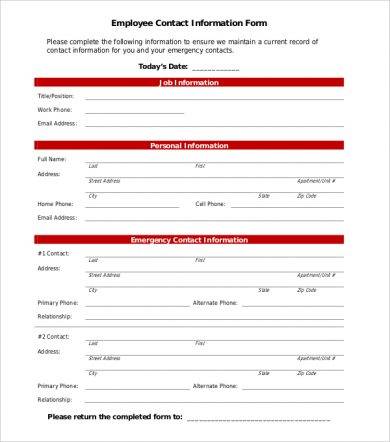
thinkpawsitive.co
Details
File Format
PDF
Size: 33 KB
New Employee Information Sheet Example
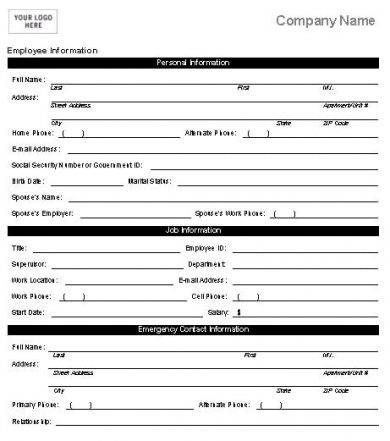
sawyoo.com
Details
File Format
PDF
Size: 26 KB
NAPSA Emergency Employee Information Form Example
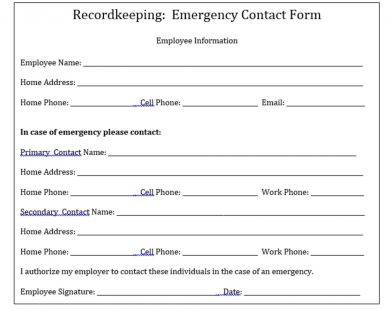
orconstructionpros.com
Details
File Format
PDF
Size: 42 KB
General Employee Information Form Example
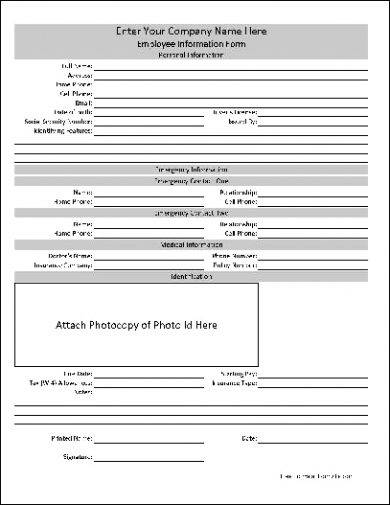
ausafahmad.info
Details
File Format
PDF
Size: 22 KB
What to Include in an Employee Information Form
Human resource personnel are usually the people tasked by management to create the information forms. But sometimes, top management creates all work-related documents to have a standardized and uniform documentation procedure for all employees in the company. Additionally, employee information forms are given to employees who are about to commence their employment with the company. You may also see examples of HR forms.
Here are some items or information that should be included when you will be making your company’s employee information form:
1. Personal details
The form comprises the most basic employee information, specifically the employee’s full name, full names of parents and siblings, gender, marital status, current and permanent addresses, landline and/or phone numbers, and email address.
You may be asking why companies want to collect and store personal records of their employees. A problem might also arise if there are also employees who do not want to disclose personal information. In actuality, employers don’t find personal information to be useful at all. They just collect the information and include them in the employee’s profile together with the other information the employee disclosed. You may also like job application form examples.
But there are some employers who use the information for verification purposes. Employers do a background check with the employee’s former employers or with relevant government agencies. If the employers find some discrepancies with the information the employee provided, he or she may be subject to disciplinary measures and further backgrounds by the company.
2. Educational background
A number of employers are strict with the educational background of their employees, especially if the job specification requires the employee to have a high school, college, or post-graduate degree. It is a fact that a degree does not really translate to the employee’s capabilities and skills, as employees are hired because of their skills and not their educational background. You may also check out interview evaluation form examples.
But employers rely on the employee’s educational background as they believe the most basic interpersonal and technical skills are taught in high school or college.
Among the information included in the educational background is the school or university in which the employee attended. Additional spaces should be included wherein the employee lists down the schools (with corresponding years) he attended, in which the spaces will be very useful for students who attended to multiple schools and finished with multiple degrees.
Also, include a section where you will be asking an employee if he plans to pursue further studies. Indicate in the specific section to let the employee expound on his decision to pursue further studies.
3. Work history (if any)
Work history is one of the most important details that should be included in any employee information form. In some information forms where the employee is able to list down his prior work experience, the information he disclosed will bear more weight than any other information he listed in the employee information form. The employee can always leave it blank if he does not have any prior work, or if he just graduated from college or high school. You might be interested in emergency information form examples.
Information regarding work history listed in the employee information form should not only be limited to the job title and duration period. It should also include the reason/s why the employee left the previous company. This helps the company create a simple analysis if the employee can be a long-term asset based on his previous work information.
4. Skills
Employers can opt to include a section where the skills of the employees will be listed down. But it is not really a necessity as employers are already aware of the skills that their employees possess as it was discussed during the job interviews and assessed during the aptitude exam. Employers can just add the section for formality purposes, and also for review purposes when they will be giving the employee additional tasks and responsibilities.
5. Government service numbers
In most countries, companies require their employees to obtain government service accounts (i.e., social security, health insurance, etc.) and enroll the said accounts with their respective companies. Companies basically pay the services in which the employee can benefit from the services in the future. In an employee information form, companies can just include a space or section where the employee lists down the account number registered with the government use. You may also see the types of HR forms you need for small businesses.
6. Character references
Character references is also an optional section in the employee information form. The character references are already listed in the employee’s CV and the employer can just retrieve that information and input it in the company’s database. Additionally, there is also a need for adding a character reference section especially if the company has its own recruitment database. You may also like performance review form examples.
7. Signatures
Signatures are always needed for any business document, either for reports, meeting minutes, contracts, or agreements. This ensures that transparency is observed for all company employees as well as for managers, officers, and top management individuals.
In an employee information form, three signatures should be fixed: the signature of the employee, the signature of his immediate supervisor or manager, and the signature of the human resource manager. Signatures do not only improve the transparency of the business but make the employee information form an official company document that can be notarized at any time especially if human resource issues arise.
Taking Advantage of HR Systems
Human resource information technology (IT) systems have been around for almost a decade now. But unfortunately, not all companies are aware that they exist.
HR systems make life easier for human resource managers and personnel. They are obviously faster and much more convenient than traditional HR methods. HR systems can also be used by both small enterprises and large corporations.
The great thing about HR systems is that most of them are free. And even the free HR systems have the same functions, if not have more functionality and better performance than the paid ones. It will be very beneficial for small startups who are still testing the waters to use free HR systems as they still try to find their footing in the market.
Human resource systems are more convenient than their traditional counterparts. Recruitment and selection are made easier since job applicants no longer need to submit hard copies of their CVs in the company, but instead, submit online with their CVs being automatically stored in the system. Human resource managers won’t have a hard time in shortlisting applicants as they can just filter and focus on data they want to retrieve in the resume, making it easier to schedule applicants for exams or interviews. Also, the company won’t have to worry about hundreds of resumes being piled on top of the other with some resumes getting lost and accidentally thrown at the trash bin or shredder.
Human resource systems also help companies store confidential employee records, which includes personal employee information as well as government service numbers, work history, and educational background. As long as there are no issues with the company’s security protocol, then security breaches can be avoided especially for the HR systems as they store around 80% of company information.
Emergency Contact Information Form Example
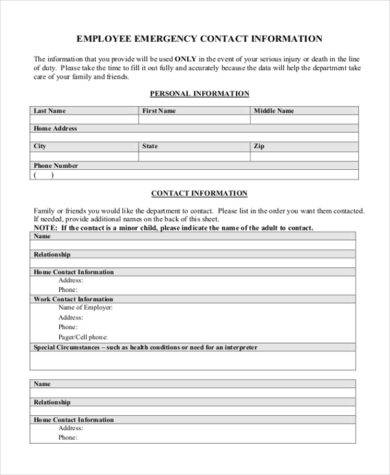
guve.securid.co
Details
File Format
PDF
Size: 41 KB
Business Employee Information Data Sheet Example

vlashed.com
Details
File Format
PDF
Size: 22 KB
Basic Employee Information Form Example
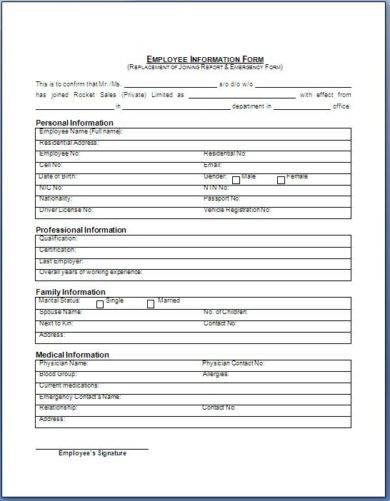
vlashed.com
Details
File Format
PDF
Size: 37 KB
Employee Information Card or Form Example

smartdraw.com
Details
File Format
PDF
Size: 44 KB
Printable Employee Information Form
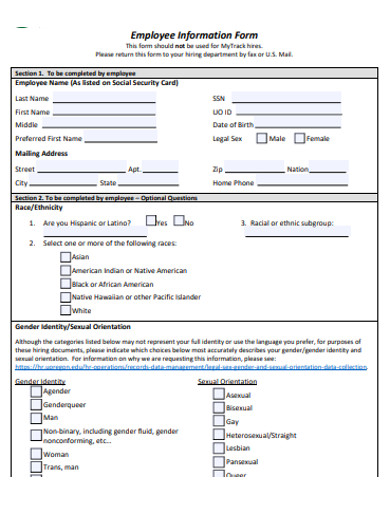
pages.uoregon.edu
Details
File Format
PDF
Size: 1 MB
Editable Employee Information Form

californiapayroll.com
Details
File Format
PDF
Size: 34 KB
Employee Information Form in PDF

uvm.edu
Details
File Format
PDF
Size: 365 KB
Sample Employee Information Form in PDF
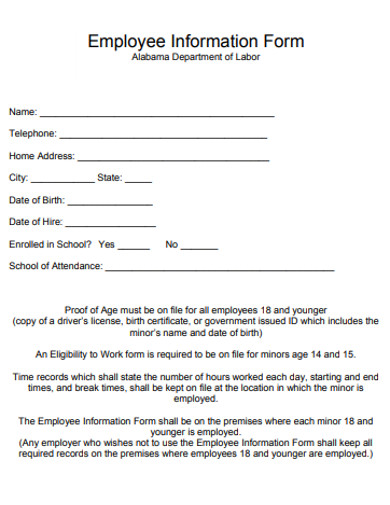
labor.alabama.gov
Details
File Format
PDF
Size: 59 KB
Printable Employee Information Form Example
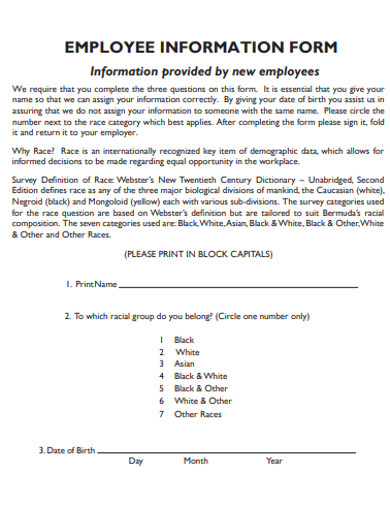
gov.bm
Details
File Format
PDF
Size: 231 KB
As mentioned above, employee information forms are highly useful. They can be used for various reasons, either for verification purposes, for relocation purposes, or even for police purposes. No matter what their uses are, they are very versatile and are not difficult to create. You may also see employee attendance form examples.
We hope the examples we provided in PDF format, as well as the tips in creating an employee information form, will help you in creating your own employee form.


